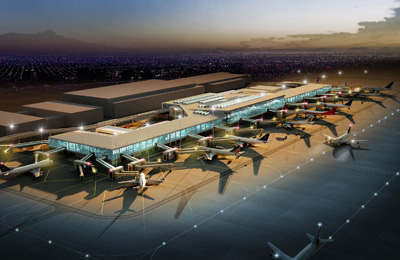
$40bn investment in Gulf airports likely
Dubai, March 9, 2014
Middle East airports have planned massive development projects to meet future demands, with the Gulf states alone investing about $40 billion in infrastrucutre, said the International Air Transport Association (Iata).
By 2017, the total passenger numbers are expected to rise to 3.91 billion worldwide, while the the Middle East region will see the strongest international passenger growth with an average of 6.3 per cent, it said.
The 14th edition of the Airport Show, a leading B2B airport industry event, will run from May 11 to 13 at the Dubai International Convention and Exhibition Centre to highlight these expansion projects.
It will also see the staging of the second edition of Global Airport Leaders’ Forum (Galf) and Travel Catering Expo (TCE) on its sidelines.
Over 250 leading global companies will be showcasing a portfolio of products, solutions and services to the regional airport industry players at show, which is expected to have a combined attendance of 7,000 attendees, 100 hosted buyers and over 100 regional aviation authorities.
Angela Gittens, director general of Airports Council International (ACI), the global body for airports, said: “Aiports are capital intensive businesses highly dependent on economies of scale. Even in a downturn airports have to invest to provide capacity for the future. The future is going to be challenging of course for airports. The aviation sector is definitely going to grow. There will be winners and losers but growth is inevitable.”
Daniyal Qureshi, director of Airport Show and Galf, said: “Airports expansion is a major area of focus for the aviation industry in almost every part of the world, especially the Middle East. Everyone now realises the importance of investment in airports keeping in mind the massive surge expected in air travellers in the coming decade.”
Dubai is executing $34 billion Dubai World Central (DWC) project which involves construction of five runways and capacity to handle 160 million passengers a year.
The Dubai Airports has been “preparing” itself to double the emirate’s passenger handling capacity to 200 million passengers a year by 2045, up from the current target of 100 million a year by 2020. It is undergoing a Dh28.8 billion ($7.8 billion) expansion programme.
Abu Dhabi will have a new 700,000 sq m airport terminal complex commissioned by 2017. It will initially handle 27 million passengers per year and will be the home of Abu Dhabi’s Etihad Airways.
Sharjah Airport is set to complete its 2030 master plan. The emirate’s growth over the past decade has been fuelled by the Gulf’s first low-cost carrier, Air Arabia. The airport reportedly handled 7.5 million passengers in 2012, a 13.6 per cent year-on-year jump from the previous year.
Oman has earmarked $6.1 billion over five years for aviation projects, which includes major terminal developments at Muscat and Salalah international airports, and completion of four new regional airports at Sohar, Ras Al Hadd, Duqm and Adam.
The new Muscat International Airport, which currently handles eight million passenger a year with an average growth of 16 per cent, is expected to see the full operations by the end of the year. It has been designed to handle 12 million passengers and can be extended to up to 48 million passengers when the need arises.
Tony Tyler, Iata’s director general and CEO, said: “The Middle East will deliver the strongest growth over the forecast period is not surprising. Governments here recognise the value of the connectivity provided by aviation to drive global trade and development.” - TradeArabia News Service







